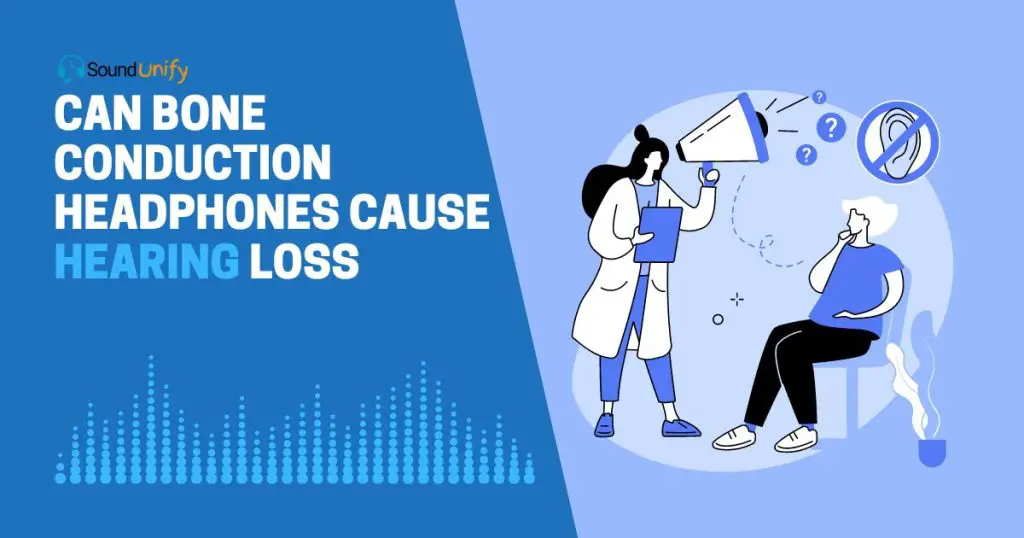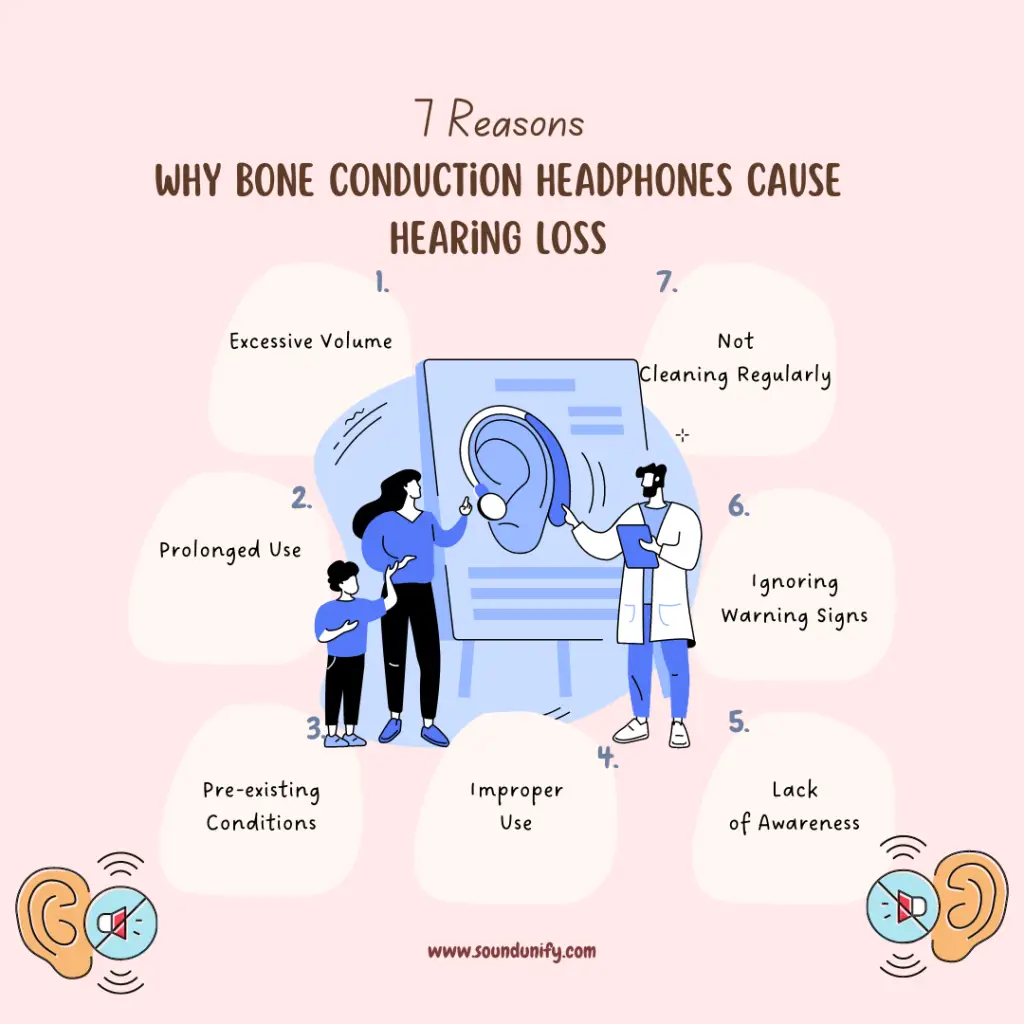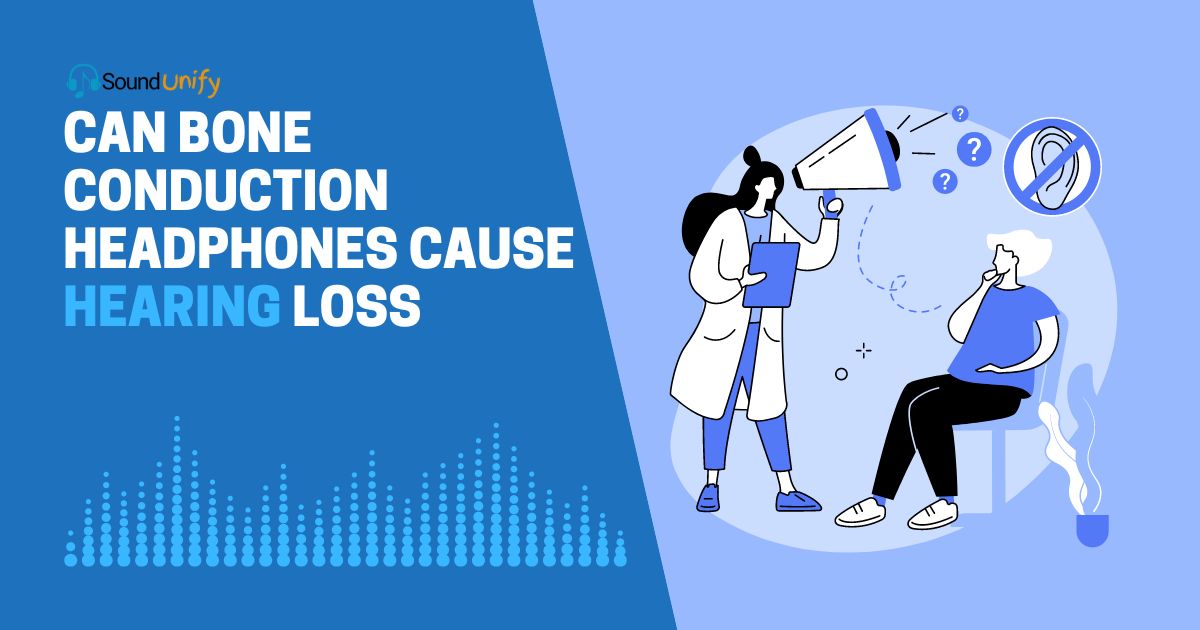Bone conduction headphones do not cause hearing loss. They're designed to protect your ears. Now, let's dive into why this is the case.
As an avid music lover and tech enthusiast, I’ve spent countless hours exploring the world of audio devices. One of the most intriguing discoveries I’ve made is bone conduction headphones.
Unlike traditional headphones, they transmit sound through your cheekbones, bypassing the eardrum entirely.
But here’s where the confusion arises: Can this unconventional method of sound transmission lead to hearing loss? It’s a valid concern, especially when we’re constantly reminded to protect our ears from loud noises.
In this blog post, I’ll unravel the science behind bone conduction headphones, debunk common misconceptions, and shed light on their impact on our hearing health.
So, if you’ve been hesitant about trying these futuristic headphones, stick around. You might be pleasantly surprised by what you learn.
The Connection Between Headphones and Hearing Loss
To know the right answer to our main topic, you should learn the basics of the headphone. I’ve spent a lot of time researching this topic. Let’s break it down.
Understanding the Basics
If you’re anything like me, you’re always curious about how things work, especially regarding technology.
So, let’s break down the basics of bone conduction headphones in a way that’s easy for anyone to understand.
Traditional Headphones vs. Bone Conduction Headphones
- Traditional Headphones: These are probably what you’re most familiar with. They work by sending sound waves through the air. These waves enter your ear canal and cause your eardrum to vibrate. This vibration is then passed on to the cochlea, translating it into electrical signals. These signals are interpreted as sound by your brain.
- Bone Conduction Headphones: These headphones work a little differently. Instead of sending sound waves through the air, they send vibrations through your bones – specifically, your cheekbones and jaw. These vibrations bypass the eardrum entirely, going straight to the cochlea. This means you can still hear sound even if your ear canal is blocked or damaged.
Table: Traditional vs. Bone Conduction Headphones
| Traditional Headphones | Bone Conduction Headphones | |
|---|---|---|
| How They Work | Send sound waves through the air | Send vibrations through your bones |
| What They Stimulate | Eardrum, then cochlea | Cochlea directly |
| Use Case | General Listening | Ideal for outdoor activities, those with certain hearing impairments |
Why Bone Conduction Headphones?
This technology isn’t new – in fact, it’s been used in hearing aids for years. But it’s only recently that it’s become popular in headphones. Why?
Because bone conduction headphones allow you to listen to your favorite tunes while being aware of your surroundings. This makes them a great choice for outdoor activities like running or cycling.
So, that’s the basics of how bone conduction headphones work. Pretty cool, right? But remember, no matter what type of headphones you use. It’s important to listen responsibly to protect your hearing.
The Science Behind the Sound
Let’s break down the science behind bone conduction headphones in a way that’s easy for anyone to understand.
Vibrations and Your Inner Ear:
When I first heard about bone conduction headphones, I was fascinated. How could vibrations in your skull translate into sound? The answer lies in your inner ear, specifically in part called the cochlea. Here’s how it works:
- The cochlea is a spiral-shaped organ filled with fluid and lined with thousands of tiny hair cells.
- When the vibrations from the bone conduction headphones reach the cochlea, they cause the fluid to ripple.
- This ripple makes the hair cells move.
- These movements are then converted into electrical signals.
- These signals are translated into sound by your brain.
Bypassing the Eardrum:
One of the unique aspects of bone conduction technology is that it bypasses the eardrum. Here’s a comparison of how traditional hearing works versus bone conduction:
- Traditional Hearing: Sound waves enter the ear canal and cause the eardrum to vibrate. These vibrations are then passed to the cochlea through small bones.
- Bone Conduction: The sound bypasses the eardrum and these bones entirely. Instead, the vibrations from the headphones are delivered directly to the cochlea.
Potential for Hearing Damage?
You might wonder, “Could these vibrations potentially damage my hearing?” It’s a valid concern. After all, our hearing is delicate and can be damaged by prolonged exposure to loud noises. However, here’s what the science says:
- The intensity of the vibrations produced by bone conduction headphones is generally not enough to cause damage to the cochlea or the hair cells within it.
- Because these headphones bypass the eardrum, they may even reduce the risk of eardrum damage compared to traditional headphones.
So, while it’s always important to listen responsibly and protect your hearing, science suggests that bone conduction headphones are a safe option.
The Intensity Factor
Regarding hearing health, the intensity of sound is a crucial factor. This refers to how loud or soft a sound is. If you’ve ever been to a loud concert or cranked up the volume on your headphones, you’ve experienced intense sound. Now, let’s see how intensity factors into using bone conduction headphones.
Bone Conduction and Intensity:
- How It Works: Bone conduction headphones transmit the sound as vibrations through your cheekbones and jaw directly to your cochlea.
- Intensity Comparison: The intensity of these vibrations is generally lower than the sound waves produced by traditional headphones. This is because the vibrations are spread over a larger area rather than concentrated in your ear canal.
Table: Intensity Comparison
| Traditional Headphones | Bone Conduction Headphones | |
|---|---|---|
| Intensity | High (sound waves concentrated in the ear canal) | Lower (vibrations spread over a larger area) |
What This Means for Your Hearing?
- Lower Intensity, Lower Risk: It’s generally accepted that lower-intensity sounds are less likely to cause hearing damage. This is good news for bone conduction headphone users.
- Potential for Damage: However, it’s important to note that listening to any sound at a high volume for extended periods can cause hearing damage.
Even though bone conduction headphones have a lower intensity factor, using them responsibly is still crucial. Keep the volume safe, and give your ears a break now and then. Your hearing will thank you…
Expert Opinions
Expert opinions and research studies are invaluable when understanding the impact of bone conduction headphones on hearing health. Here’s what some of the leading studies have to say:
Key Findings from Research Studies:
- Study: “Incapacitating Unilateral Tinnitus in Single-Sided Deafness Treated by Cochlear Implantation” by Paul Van de Heyning et al.
- Finding: Electrical stimulation via a cochlear implant resulted in a significant reduction in tinnitus loudness.
- Implication: This suggests that direct cochlea stimulation, similar to bone conduction headphones, can positively affect hearing health.
- Study: “Myogenic potentials generated by a click-evoked vestibulocollic reflex” by James G. Colebatch, G. Michael Halmagyi, and N F Skuse.
- Finding: The earliest potential change in response to sound was preserved in subjects with severe sensorineural hearing loss.
- Implication: This indicates that bone conduction headphones, which bypass the eardrum, could still be effective for individuals with certain types of hearing loss.
- Study: “The Impact of Hearing Loss on Quality of Life in Older Adults” by Dayna S. Dalton et al.
- Finding: The severity of hearing loss is associated with reduced quality of life in older adults.
- Implication: While this study doesn’t directly address bone conduction headphones, it underscores the importance of protecting our hearing health, which includes using headphones responsibly.
- Study: “Speech perception problems of the hearing impaired reflect inability to use temporal fine structure” by Christian Lorenzi et al.
- Finding: Using temporal fine structure may be critical for “listening in the background dips.”
- Implication: This could be relevant to bone conduction headphones, which deliver sound differently than traditional headphones.
Table: Summary of Key Findings
| Study | Key Finding | Implication |
|---|---|---|
| Van de Heyning et al. | Electrical stimulation via a cochlear implant reduced tinnitus loudness | Direct stimulation of the cochlea, as with bone conduction headphones, can have positive effects on hearing health |
| Colebatch, Halmagyi, and Skuse | Earliest potential change in response to sound preserved in subjects with severe sensorineural hearing loss | Bone conduction headphones could be effective for individuals with hearing loss. |
| Dalton et al. | The severity of hearing loss associated with reduced quality of life in older adults | Importance of protecting hearing health, including responsible use of headphones |
| Lorenzi et al. | Ability to use temporal fine structure critical for “listening in the background dips.” | Relevance to bone conduction headphones, which deliver sound differently |
These studies provide valuable insights into the potential impact of bone conduction headphones on hearing health. However, more research is needed to fully understand the long-term effects of using these devices.
So Can Bone Conduction Headphones Cause Hearing Loss?

This is the million-dollar question. After all, we all want to enjoy our favorite tunes without risking our hearing health. So, let’s get straight to the point.
Based on current understanding and research, bone conduction headphones do not appear to cause hearing loss. Here’s why:
- Lower Intensity: Bone conduction headphones produce vibrations that are generally less intense than the sound waves produced by traditional headphones. Lower-intensity sounds are less likely to cause hearing damage.
- Bypassing the Eardrum: These headphones deliver sound by sending vibrations through your cheekbones and jaw, bypassing the eardrum entirely. This may reduce the risk of eardrum damage, which loud noises can cause.
- Expert Opinions: Research studies and expert opinions suggest that bone conduction headphones can be a safe and effective way to listen to audio. Some studies even suggest potential benefits for individuals with hearing loss.
However, it’s important to remember that any audio device, if used improperly, can harm your hearing. This includes both traditional and bone conduction headphones.
So, while bone conduction headphones don’t appear to cause hearing loss, they should still be used responsibly. You can question why bone-conduction headphones cause hearing loss.
7 Reasons Why Bone Conduction Headphones Cause Hearing Loss

While the current understanding and research suggest that bone conduction headphones do not cause hearing loss, it’s important to consider all possibilities.
There are a few theoretical reasons why bone conduction headphones could potentially contribute to hearing loss.
Although these are largely speculative and not supported by substantial evidence. Here are a few:
1. Excessive Volume
Like any audio device, bone conduction headphones can cause hearing damage if the volume is too high. Even though the sound is transmitted through bone, loud volumes can still potentially damage the hair cells in the cochlea.
Solution:
- Always keep the volume at a safe level.
- Avoid cranking up the volume to drown out background noise.
2. Prolonged Use
Using headphones for extended periods without breaks can strain your hearing system and lead to fatigue or damage. This is true for both traditional and bone conduction headphones.
Solution:
- Take regular breaks when using headphones.
- Try not to use headphones for several hours at a stretch.
3. Pre-existing Conditions
For individuals with certain pre-existing conditions, such as osteoporosis or other diseases that affect bone density. It’s theoretically possible that the vibrations from bone conduction headphones could cause discomfort or further complications.
Solution:
- If you have a pre-existing condition, consult your healthcare provider before using bone conduction headphones.
- Always listen to your body and stop using the headphones if you feel discomfort.
4. Improper Use
Using bone conduction headphones improperly, such as wearing them too tightly or placing them incorrectly, could lead to discomfort or even temporary changes in hearing.
Solution:
- Ensure you wear your headphones correctly, according to the manufacturer’s instructions.
- Adjust the fit if you feel any discomfort.
5. Lack of Awareness
Because bone conduction headphones allow you to hear ambient noise, you might be tempted to use them when it’s unsafe to wear, like crossing a busy street or driving.
Solution:
- Always stay aware of your surroundings when using bone conduction headphones.
- Avoid using headphones in situations where they could compromise your safety.
6. Ignoring Warning Signs
If you’re experiencing discomfort or changes in your hearing while using bone conduction headphones, it’s important not to ignore these signs.
Solution:
- Stop using the headphones if you notice any discomfort or changes in your hearing.
- Consult with a healthcare professional if you have any concerns about your hearing.
7. Not Cleaning Regularly
Like any personal device, bone conduction headphones can accumulate dirt and bacteria over time, potentially leading to ear infections.
Solution:
- Clean your headphones regularly according to the manufacturer’s instructions.
- Avoid sharing your headphones with others to prevent the spread of bacteria.
FAQs
Do bone conduction headphones damage your hearing?
Current evidence suggests that bone conduction headphones do not cause hearing loss. However, more research is needed to understand their long-term effects fully.
How do bone conduction headphones work?
Bone conduction headphones send vibrations through your cheekbones and jaw, bypassing the eardrum and stimulating the cochlea.
Are bone conduction headphones safe?
Yes, bone conduction headphones are generally considered safe. They allow you to listen to audio without blocking your ear canal, so you can still hear ambient sounds.
Can you use bone conduction headphones if you have hearing loss?
Yes, bone conduction headphones can be a great option for people with hearing loss, as they bypass the eardrum and directly stimulate the cochlea.
What are the benefits of bone conduction headphones?
The main benefit of bone conduction headphones is that they allow you to listen to audio without blocking your ear canal. This means you can still hear what’s happening around you, which can be safer when you’re out and about.
Final Thoughts
Bone conduction headphones are a fascinating technology that offers a unique listening experience. While they’re generally considered safe, using them responsibly to protect your hearing health is crucial.
Remember, any audio device can potentially cause hearing damage if misused. So, keep the volume down, take regular breaks, and listen to your body. Interested in learning more?
Check out our article on the “side effects of bone conduction headphones” for a deeper dive into this topic. Stay informed, stay safe, and enjoy your music.
Related Articles
James Dimento is a Chief-in-Editor of SoundUnify. He is a headphone enthusiast and creative writer passionate about audio technology. He has three years of experience writing about headphones and sound quality and is responsible for creating reviews and taking care of all administration.
